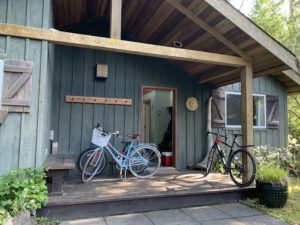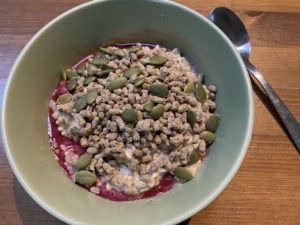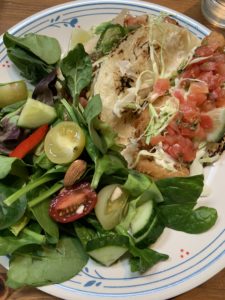Travelling with T1D is not always easy, especially when it comes to food.
Hi friends!
Last week, this T1D dietitian spent a refreshing week soaking up the wind and waves in Tofino, BC with my family.

It was a very much needed vacation for all of us, but it came with a host of challenges for me – most notably, food.
My family and I have not taken a proper vacation since pre-Covid. In fact, my last vacation was with my son in Arizona just before heightened Covid precautions hit.
We actually made it home just in the nick of time as the borders were closing.
Needless to say, I was a bit out of practice with my pre-travel preparations.
Food Challenges
Travelling to Tofino is an all-day affair involving copious amounts of driving and a ferry trip across the ocean. There was a lot of sitting and not much movement, which can be temperamental to blood sugars on its own.
But beyond that, meals were my main challenge.
Thankfully, we were able to pack some go-to foods with us, because we were not limited by flight restrictions, which was super helpful.
We were also staying in a rented house, which meant we had a kitchen at our disposal – a huge asset for people travelling with T1D.
But still, there were more restaurant meals than usual, and foods that I wouldn’t typically eat in my day-to-day life.
I don’t know about you, but eating out all the time definitely takes a toll on my blood sugars and my mental health.
The anxiety of perusing menus and determining if the restaurant will have something suitable for guesstimating carbs and blood-sugar management is significant.
Don’t get me wrong, I’m all for treating myself once in awhile, but the key is once in awhile. I do not want my blood sugars wreaking havoc on me 90% of a trip. That would not be a fun trip for me.
Food Solutions for Travelling with T1D
So, what do I do?
I prepare as best I can. I try to remove unnecessary variables, and use the tools available at my disposal.
The following is a list of tools I utilize for travel.
Kitchen:
When we vaca, we rarely stay in hotels. My number one must have for travel accommodations is a kitchen. A fully-functioning kitchen allows me to have at least one prepared meal that I know will be okay on my blood sugars.
For this trip, we dined on eggs, trout, and spot prawns, all paired with a large salad and side of bread.
We brought the salad grains, bread and eggs with us (Tofino groceries are not cheap), but if you’re flying to your destination, these are all foods that can be easily acquired at the local grocery store.

Breakfast:
I have been eating oatmeal nearly every morning for more than 15 years. This is my most favourite meal of the day, and it is also the meal that I know 90% of the time will be okay on my blood sugars.
However, packing cooked steel cut oats is not the easiest for a trip away – even when driving.
For this trip, I packed individual mason jars of overnight oats. I knew we weren’t gone long enough for them to expire, and this option was the easiest.

If we were flying, I could have packed the measured dry ingredients individually and then picked up the wet ingredients at our destination and make overnight oats from that. Or, I could have packed dry ingredients and batch cooked at our destination. For this option, I would have also brought my go-to measuring spoons and cups.
I don’t measure all foods, but breakfast is a meal that I do, because it helps to start my day with behaving blood sugars.
Salads:
Every lunch and dinner is paired with a salad, preferably a half plate. This helps reduce the excess carbs that restaurants tend to load on plates with their sides. It also ensures I’m getting a boost of fibre, which is going to benefit my blood sugars and my bowels.
I request the dressing on the side at restaurants, because often those dressings are loaded with sugar. And this is an area that I can control with my take-out meals.

Staples:
Other staples I like to have on hand include plain Greek yogurt, frozen raspberries, almonds, apples, and Simply Protein bars. The almonds and granola bars can be packed ahead, and the apples and Greek yogurt can be purchased at my destination. I eat apples nearly every day, so I generally know by looking how many carbs an apple is going to provide.
Having these go-to snacks on hand takes the guess work out of eating on the go.
What are your go-to nutrition travel tips for T1D?
